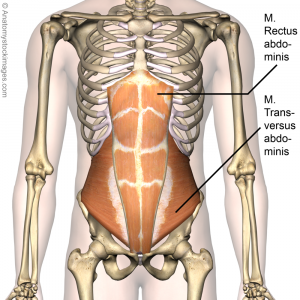Transversus Abdominis: Difference between revisions
Kim Jackson (talk | contribs) m (Text replacement - "[[Core stability" to "[[Core Stability") |
No edit summary |
||
| Line 5: | Line 5: | ||
</div> | </div> | ||
== Description == | == Description == | ||
[[File:Torso-rectus-abdominis-transversus-abdominis.png|right|frameless]] | |||
The transverse abdominal (TA) muscle is the deepest of the 6 abdominal muscles. It extends between the ribs and the pelvis, wrapping around the trunk from front to back. The fibers of this muscle run horizontally, similar to a back support belt. In this way, along with providing postural support, the transverse abdominal muscle helps to contain and support the organs located inside the trunk<ref name=":1">Very well health TrA<nowiki/>https://www.verywellhealth.com/transverse-abdominal-muscle-297289 (accessed 13.12.2021)</ref>. | |||
TrA is one of the main [[Core Stability|core muscles]] that support of the lumbopelvic region. | |||
=== Origin === | === Origin === | ||
| Line 13: | Line 16: | ||
=== Insertion === | === Insertion === | ||
The transverse abdominal muscle inserts onto the xiphoid process, the linea alba (a tendon that runs vertically from ribs to the pelvis and separates the right and left sides of the superficial rectus abdominus muscle) and the pubic symphysis joint<ref name=":1" />. | |||
=== Nerve === | === Nerve === | ||
| Line 19: | Line 22: | ||
=== Artery === | === Artery === | ||
Receive blood supply from the lower posterior intercostal and subcostal arteries, superior and inferior epigastric arteries, superficial and deep circumflex iliac arteries, posterior lumbar arteries. | Receive blood supply from the lower posterior intercostal and subcostal arteries, superior and inferior epigastric [[arteries]], superficial and deep circumflex iliac arteries, posterior lumbar arteries. | ||
== Function == | == Function == | ||
| Line 31: | Line 34: | ||
Transverse abdominis is a deep [[Abdominal Muscles|abdominal muscle]] and an important core muscle inhibition or inadequate activation contributes to [https://physio-pedia.com/Low_Back_Pain?utm_source=physiopedia&utm_medium=search&utm_campaign=ongoing_internal low back pain], lumbar instability<ref name=":0">Lynders C. [https://link.springer.com/article/10.1007/s11420-019-09717-8 The Critical Role of Development of the Transversus Abdominis in the Prevention and Treatment of Low Back Pain.] HSS Journal®. 2019 Oct 1;15(3):214-20.</ref> | Transverse abdominis is a deep [[Abdominal Muscles|abdominal muscle]] and an important core muscle inhibition or inadequate activation contributes to [https://physio-pedia.com/Low_Back_Pain?utm_source=physiopedia&utm_medium=search&utm_campaign=ongoing_internal low back pain], lumbar instability<ref name=":0">Lynders C. [https://link.springer.com/article/10.1007/s11420-019-09717-8 The Critical Role of Development of the Transversus Abdominis in the Prevention and Treatment of Low Back Pain.] HSS Journal®. 2019 Oct 1;15(3):214-20.</ref> | ||
''' | [[Trigger Points|Trigger point]]''':''' abdominal trigger points may be a primary cause of abdominal pain or an associated /secondary condition. | ||
The costal attachment of TrA refers pain to the anterior abdomen, xiphoid process it's local pain. | The costal attachment of TrA refers pain to the anterior abdomen, xiphoid process it's local pain. | ||
Revision as of 05:48, 13 December 2021
Original Editor - Khloud Shreif
Top Contributors - Lucinda hampton, Khloud Shreif, Kim Jackson, Candace Goh, Joao Costa, Wanda van Niekerk and Oyemi Sillo
Description[edit | edit source]
The transverse abdominal (TA) muscle is the deepest of the 6 abdominal muscles. It extends between the ribs and the pelvis, wrapping around the trunk from front to back. The fibers of this muscle run horizontally, similar to a back support belt. In this way, along with providing postural support, the transverse abdominal muscle helps to contain and support the organs located inside the trunk[1].
TrA is one of the main core muscles that support of the lumbopelvic region.
Origin[edit | edit source]
TrA arises from more than one origin;
Lateral third of inguinal ligament and associated iliac fascia, anterior two-third of the iliac crest, thoracolumbar fascia, and inner surface of lower six costal cartilage and their ribs(7-12)
Insertion[edit | edit source]
The transverse abdominal muscle inserts onto the xiphoid process, the linea alba (a tendon that runs vertically from ribs to the pelvis and separates the right and left sides of the superficial rectus abdominus muscle) and the pubic symphysis joint[1].
Nerve[edit | edit source]
Innervated by lower five intercostal nerves, subcostal nerve, ilioinguinal L1 and iliohypogastric L1
Artery[edit | edit source]
Receive blood supply from the lower posterior intercostal and subcostal arteries, superior and inferior epigastric arteries, superficial and deep circumflex iliac arteries, posterior lumbar arteries.
Function[edit | edit source]
With other abdominal muscles, TrA helps to maintain abdominal tension and support abdominal viscera, increase intraabdominal pressure that is helpful in forceful expiration, coughing, defecation.
It's an important core muscle that supports lumbopelvic during our movement[2].
Unilateral action: ipsilateral trunk rotation
Clinical Relevance[edit | edit source]
Transverse abdominis is a deep abdominal muscle and an important core muscle inhibition or inadequate activation contributes to low back pain, lumbar instability[4]
Trigger point: abdominal trigger points may be a primary cause of abdominal pain or an associated /secondary condition.
The costal attachment of TrA refers pain to the anterior abdomen, xiphoid process it's local pain.
The suprapubic attachment refers pain inferiorly and medially.[5] If there is a trigger point patient may present with distressing cough
Palpation[edit | edit source]
In crook lying position, find the ASIS, and move two inches toward the midline then one inch inferior apply light pressure. When the muscle is contracted you will feel muscle tension popping under your finger.
Treatment[edit | edit source]
Drawing in technique is the most effective technique to activate and strengthen TrA as well as diaphragm it has a positive effect also on LBP and respiratory pattern[6]. Exercise be graduated from maintaining static contraction to be involved in more dynamic and functional activities, and apply it with other core exercises.
When applying technique you shouldn't squeeze buttocks, flatten the back, or bear down, pressing back into the surface activate superficial abdominal muscles with TrA, and pelvic tilting activates the rectus abdominis also.[4]
Resources[edit | edit source]
References[edit | edit source]
- ↑ 1.0 1.1 Very well health TrAhttps://www.verywellhealth.com/transverse-abdominal-muscle-297289 (accessed 13.12.2021)
- ↑ Selkow NM, Eck MR, Rivas S. Transversus abdominis activation and timing improves following core stability training: a randomized trial. International journal of sports physical therapy. 2017 Dec;12(7):1048.
- ↑ AnatomyOnlineCourse. Clinician Education: Transversus abdominis - AnatomyOnlineCourse. Available from: http://www.youtube.com/watch?v=S6hqhnSM-MU[last accessed 25/4/2020
- ↑ 4.0 4.1 Lynders C. The Critical Role of Development of the Transversus Abdominis in the Prevention and Treatment of Low Back Pain. HSS Journal®. 2019 Oct 1;15(3):214-20.
- ↑ nielasher.com/blogs/video-blog/trigger-point-therapy-transversus-abdominis
- ↑ Oh YJ, Park SH, Lee MM. Comparison of Effects of Abdominal Draw-In Lumbar Stabilization Exercises with and without Respiratory Resistance on Women with Low Back Pain: A Randomized Controlled Trial. Medical Science Monitor: International Medical Journal of Experimental and Clinical Research. 2020;26:e921295-1.
- ↑ Dr Deborah Riczo. Learn the easiest way to activate Transverse Abdominis (TVA) muscle with Dr. Deb, physical therapist. Available from https://www.youtube.com/watch?v=MGvQNzhxBWo (last accessed 21 June 2021)











